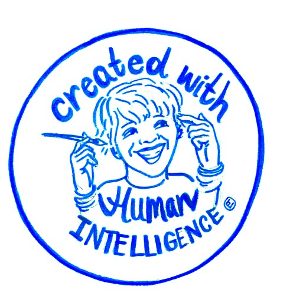The revolution will be hand-drawn
How a book illustrator started a mini-movement for human intelligence
When it comes to AI “training” methods and the way human creative output of all kinds is relentlessly sucked into its insatiable maw, there are two core issues vexing those who produce that creativity.
The first, of course, concerns the theft of one’s intellectual material for the purpose of further enriching tech giants with no respect for copyright law. But the other, less discussed issue is that as the thievery continues and the algorithms grow ever more astute, we will soon have no way to distinguish between synthetic content and the original work of a flesh-and-blood human.
Book illustrator Beth Spencer, in the fashion of many who pursue more artistically inclined lines of work, decided to literally take matters into her own hands. She began to noodle on some designs to try and designate the art she was creating as the result of “human intelligence.” It didn’t take long for her to put this together:
She decided to put it out into the world on her social channels, offering it to like-minded artists for use on their own, human-created work. What followed was a beautiful tsunami of creative expression.
Not only did others use her design, but after Beth encouraged others to create their own version on Instagram, artist after artist threw their creations into the mix. Soon, all manner of human intelligence stamps were circulating among the ad hoc community. Some samples:
More and more artists threw in their creations. The movement grew. People started to notice. Forbes wrote a piece about it, quoting Beth extensively along with other participating artists.
What’s the lesson here? There are several. It’s a reminder of the simple power inherent in the DIY impulse. It’s a testament to the desire for community and the way outsider voices can suddenly merge into a wild tornado-y jumble of expression.
But more than anything, it’s a celebration of human creative output, and the desire to make sure we continue to have a way to identify it as such. Because in and of itself, humans are important.
That such a sentiment needs to be expressed is deeply odd. But given the approach currently being taken by the purveyors of AI, in which the creation and enjoyment of human-created art are both treated as nagging inconveniences, it’s necessary.
Mateo Montoya, one of the other artists from the Forbes piece (here’s his contribution to the gallery), expressed it this way: “What we illustrators, designers and artists do not only fulfills an aesthetic function, it fulfills a communicative function. Our work is a very powerful tool to express what we think and feel.”
Some lines of communication are worth keeping open.








